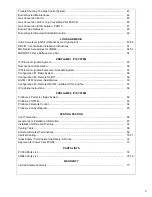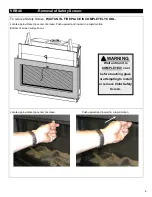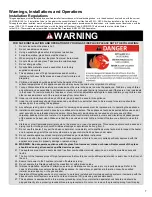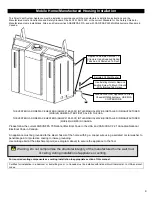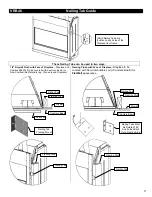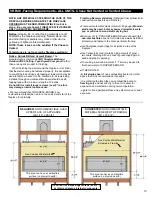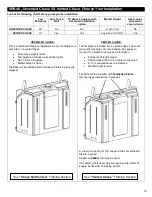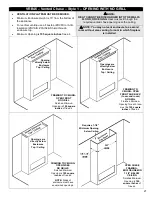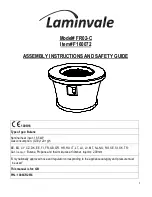
V
RB46
Framing Your Gas Fireplace
This section is intended for qualified installers only. Before beginning, make note of where the gas and electrical accesses are
located on the unit. This will streamline the construction process. Furthermore, familiarize yourself with the venting and
clearance requirements (see Venting section) for this appliance. Failure to comply with those requirements can seriously
compromise the safety and operation of the fireplace.
Specifications
1. Cold climate installation recommendation: When installing this fireplace against non insulated exterior wall or chase,
it is recommended that the outer walls be insulated to conform to applicable insulation codes. Drywall & vapor barrier
must be installed over insulation to prevent contact of insulation and unit.
2. Choose fireplace location and frame in accordance with the fireplace framing dimensions specified (view diagrams).
3. Drywall or other combustible material can extend up to the Drywall Stops located on the sides of the unit, and up to
the bottom and top.
4. A Hearth is not required for this unit.
Certified for installation in a bedroom or bedsitting room. In Canada must be installed
with listed millivolt thermostat (Not permitted for decorative vented gas fireplaces installed
in the U.S.A.). In USA see local codes.
Stand-off Locations
Make note of where the stand-off locations are. These stand-offs are provided as indicators to illustrate the
boundaries for framing. Therefore, no framing material is permitted to extend beyond these stand-offs.
Vertical Venting in Cold Climates
In cold climate conditions where temperatures go below -10 degrees Celsius or 14 degrees Fahrenheit, we recommend
that the chase be insulated and where the vent pipe enters into the attic space that the pipe be wrapped with an
insulated Mylar sleeve. This will increase the temperature of the vent and help the appliance to vent properly in cold
weather conditions.
It is also important in vertical vented direct vent appliances that the appliance be operated daily during the winter months
as this will help stop the termination from freezing up. We recommend using a thermostat (Not permitted for decorative
vented gas fireplaces installed in the U.S.A.) set at room temperature to allow the unit to cycle.
For IPI models it may be necessary to set the appliance to Standing Pilot mode to maintain heat in the cavity. The
purpose of this procedure is to prevent cold air from penetrating the chimney and then onto the living space. Therefore,
when the internal temperature is slightly elevated the fireplace is able to freely exhaust its combustion and hence making
it easier to startup.
Nailing Tabs
Caution:
Standoffs on top of the unit
must be folded into position & screwed
down
Prior
to installation.
Holes are provided in bottom of
unit to secure appliance to floor
after installation.
10



